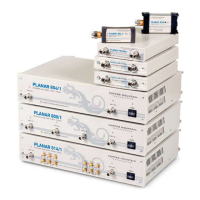This section describes the differences in the methods of writing user programs due
to the use of different HiSLIP and TCP/IP Socket protocols. It is assumed that the
user program works through the VISA library.
The list of differences in a brief form is given below. Then a detailed description of
each item is given.
1. The terminal character <newline> in the commands sent to the analyzer.
2. The terminal character <newline> in the analyzer's responses.
3. Determine the interrupted violation of the messages exchange protocol of
IEEE488.2.
4. Support for the IEEE488.2 Status Reporting System.
5. Support the transfer of binary data.
2.7.1 Terminal Character in Messages to Analyzer
The user program sends variable-length text messages to the analyzer. The end of
the message, according to IEEE488.2, is transmitted either by protocol means (not
by a symbol), or by the symbol <newline> ('\n', 0x0A, 10), or both methods
together.
The HiSLIP has a mechanism for transmitting the end of the message by protocol
means, while the Socket protocol does not. This makes the following requirements
for programs sending commands to analyzer:
Programs using the Socket protocol shall send a <newline> character at the
end of the message;
Programs using the HiSLIP protocol may send the <newline> symbol at the
end of the message.
Note for the graphical language LabVIEW when using the Socket protocol: to be able
to enter the symbol <newline> at the end of the message, you need to right-click
on the string constant and enable '\' Codes Display. The <newline> character is
entered as '\n'.
Note for the textual languages: it is recommended to use to the symbol <newline> at
the end of the message regarless of the protocol used.

